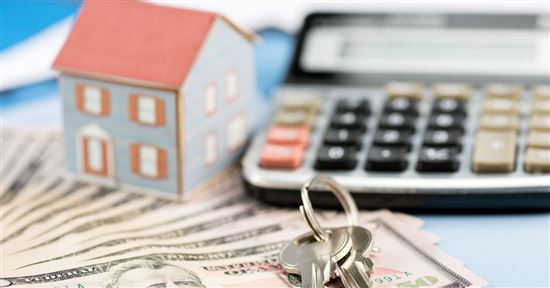Study: Average Mortgage Payment
The average mortgage payment is on the rise at $758 a month. Can you afford a mortgage? Read on for the surprising mortgage payment facts and trends.
 |
Mortgage Payments on the Rise
The declining prices of the housing crisis seem to be behind us. What is left are rising mortgage payments and incomes that don't keep pace.
- How much is the average mortgage payment?
In 2016, the average mortgage payment saw an almost 10% increase from the prior year. It jumped from $690 to $758 thanks to rising home values and interest rates. Unfortunately, what's not rising is household incomes. If they are rising, it's not enough to keep up. - How much of the average borrower's income does the mortgage payment take up?
In 2016, borrowers paid as much as 15.6% of their income to their mortgage. This is the largest portion mortgages have taken of the average American's income. In 2015, the average household paid 14.7% of their household income to their mortgage. - How much of the average renter's income does rent take up?
More than 43.3 million households rent. Renters pay an average of 30% of their paycheck to their landlord. 21 million renters are cost-burdened. It's difficult for them to afford their rent payments. This is in comparison to 18 million homeowners who are cost burdened. - How much does the average household income grow in comparison to mortgage payment growth?
Unfortunately, the average U.S. household income only grew 2.2% from the previous year. Rising home values and interest rates made mortgages more unaffordable. Home values are expected to rise another 17.3% over the next 5 years. If the household income keeps its same slow pace, it could be harder for potential homeowners to buy a home. - What's the average list price for homes in the United States?
There's a difference between the list price and the average value. During the first quarter of 2017, the average list price was 25.3% higher than the average value. Sellers ask an average of $246,900 for their homes. In reality, the median home value was just $197,100, though. - What's the largest reason renters have for not buying a home?
It all comes down to savings. With more than 30% of the average renter's income going towards their rent, it makes sense. Two-third of renters cited the down payment was the sole reason they still rent. Unfortunately, home values are on the rise. This means higher down payment requirements, which isn't good news for renters.
Making Heads or Tails Out of Your Mortgage Payment
How much should you borrow? What is an affordable mortgage payment? It can all make your head spin. We cover the basics here to help you make sense of the confusing mortgage industry.
- How much of your income should go towards your mortgage?
Try not to allocate more than 28% of your gross monthly income towards your mortgage. This should allow you money for other necessities. This includes house maintenance, savings, and daily living expenses. - Can you afford a mortgage?
Before you close on a loan, consider if you can really afford it. This doesn't mean just passing the 28% rule test. It means looking at the real numbers.Compare the mortgage payment to your current rent payment. Is it much higher? Do you have room in your budget for it? Next look at your daily living expenses: is there enough money left to cover them? Last, look at what's left. Are you able to save any money? You should estimate around 1% of your home's value in home maintenance per year. Will you have that amount?
If you answered yes to each question, chances are you may be able to afford a mortgage.
- What is a front-end ratio?
Another word for the front-end ratio is your housing ratio. It's the amount of your total mortgage payment divided by your gross monthly income. Lenders use this figure as a part of the approval process. But they pay more attention to the total debt ratio, which we discuss below. - What should the debt to income ratio be?
Most lenders don't allow debt ratios higher than 43%. History shows that borrowers with DTIs higher than 43% have trouble making their mortgage payments. - How do you calculate the debt to income ratio?
Your total debt and total monthly income make up your DTI. The calculation is as follows:Total debt/Total income = Total debt ratio
For example, if your total debt is $2,500 and your monthly income equals $3,900, your calculation would be:
$1,500/$3,900 = 38%
- How do you calculate interest on a mortgage?
The interest rate is the price you pay to borrow the money. It's the bank's profit. For example, a 4% interest rate is the annual rate.You can figure your interest by dividing the quoted rate by 12 months. For instance, a 5% interest rate would cost .42% per month. On a $150,000 mortgage, you'd pay:
$150,000 x .4167% = $625 in interest the first month
This amount drops slightly each month as you pay the principal balance down. On a 30-year fixed rate mortgage at 5%, your payment would equal $805.23. Of this amount, the first month's payment covers $180.23 in principal. Your second month's interest would equal around $624.29. It would continually decrease from there.
- How do you calculate the monthly mortgage payment on a mortgage?
Your mortgage payment consists of more than the principal and interest. A full mortgage payment is comprised of PITI. This stands for principal, interest, taxes, and insurance.Once you know your P&I payment from the calculation above, you can add your T&I. You will hear your real estate taxes as a flat amount or as a percentage of your sale price.
Let's say your taxes are $10,000 per year. You'd take $10,000/12 = $833.33 per month. Your insurance is your homeowner's insurance and your PMI (if applicable). You use the same calculation, dividing the total by 12. This gives you your monthly homeowner's insurance payment. Your total PITI = principal + interest + taxes + insurance (homeowner's and PMI).
- How do you calculate PMI?
You'll need a few bits of information to calculate your PMI (Private Mortgage Insurance). First, you need the LTV. This is the borrowed amount compared to the home's value.Let's say you have a $250,000 loan on a home worth $300,000. Your LTV equals 83%. You use the LTV to find your corresponding PMI rate on the lender's chart. In this case, you'd need 12% coverage:
$250,000 x .12 = $300
You then divide the amount by 12 months to determine your monthly rate:
$300/12 months = $25 per month
- How can you avoid paying PMI?
You need at least a 20% down payment to avoid paying PMI on a conventional loan. With more than 20% invested in your home, you're more likely to pay your mortgage. Less than 20% down means a higher risk of default. Lenders make up for this risk with mortgage insurance. - What is the monthly payment on a $300,000 mortgage?
At an interest rate of 4.5%, the monthly payment on a $300,000 mortgage equals $1,520 on a 30-year fixed loan. This accounts just for principal and interest. You still have to figure in your taxes, insurance, and Private Mortgage Insurance (if applicable). - How much should you spend on a house if you make $100k a year?
Using the 28% rule of thumb, your mortgage payment shouldn't exceed $2,333. This is 28% of your $100,000 per year salary on a monthly basis.For this example, we'll use a 4.5% interest rate. We also use 2% of the sales price for property taxes and 1% for homeowner's insurance.
With these figures, you could afford a mortgage of around $290,000.
This doesn't mean you can buy a $290,000 house, though. You still need a down payment. With a 20% down payment, you could afford a $360,000 house. Your mortgage payment would equal $1,459.
You'll need to add property taxes and homeowner's insurance of around $900. This gives you a mortgage payment equal to 28% of your gross monthly income.
- How much should you spend on a house if you make $60,000 a year?
Using the 28% rule of thumb, your mortgage payment should be around $1,400. This includes taxes and insurance.With an average 4.5% interest rate on a 30-year loan, 2% for taxes, and 1% for homeowner's insurance, your mortgage shouldn't exceed $175,000. With a 20% down payment, you could buy a home for $210,000. Principal and interest on this amount equals $887. We estimated taxes of around $350 per month and homeowner's insurance of around $175 per month.
- How many FHA loans are for first-time homebuyers?
82% of the FHA loans written in 2016 were for first-time homebuyers. But you don't have to be a first-time homebuyer to take out an FHA loan. It's just the program that worked for them. - What are the top reasons sellers don't like FHA loans?
The FHA program has many myths surrounding it. Horror stories of ridiculous inspections and delayed closings cause sellers to avoid FHA buyers. Among the top reasons sellers avoid this program include:- Many people look at FHA borrowers as "marginally qualified." Sellers worry that the sale will fall through.
- Many sellers still think the FHA inspection requirements are harsh. They worry that the closing will be delayed or the closing will cost them too much. In reality, they aren't much different than any other program.
- The allowance of seller paid closing costs often turns sellers off too. They think they have to contribute to the buyer's costs. In reality, they can contribute if they want, but they are never required to do so.
- Many people look at FHA borrowers as "marginally qualified." Sellers worry that the sale will fall through.
- What is a great credit score?
Lenders only consider credit scores over 750 as great. But you don't need a great score to get a loan. Conventional loans usually require credit scores of at least 680. On the credit reporting scale, this is considered fair. - What is a poor credit score?
A poor credit score might make it difficult for you to get a conventional loan. Most credit scoring models consider scores between 550 and 649 poor. If you have a decent down payment, you still may secure lending, though. FHA loans and subprime loans are the two most common options. - What is a subprime mortgage?
Subprime sounds bad, but if you have poor credit, it may be your only option. It just means it's not a loan sold on the conventional market. Individual lenders fund the loan. They have the say in the requirements. They may even bend the rules for you. The more "good" factors you have for them, the better your chances of approval. Think of things like assets, stable employment, and increasing income.
The Bottom Line
Using our guidelines, you can see for yourself what you can afford. 28% of your income is a great rule of thumb to use. Don't forget to plug the numbers into your own budget, though. Only you know what you can truly afford. Crunch the numbers yourself before letting any banker or real estate professional tell you what you can afford.
Sources and References:
Write to Kim P at feedback@creditdonkey.com. Follow us on Twitter and Facebook for our latest posts.





